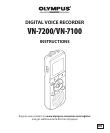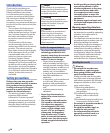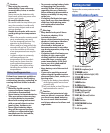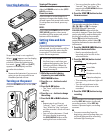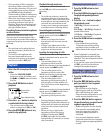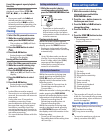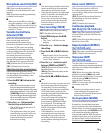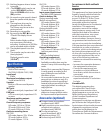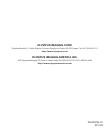
9
EN
Q2: Nothing happens when a button
is pressed.
A2: • The
POWER switch may be set
to the [OFF/HOLD] position.
Slide the
POWER switch to the
[ON] position.
Q3: No sound or quiet sound is heard
from the speaker while playing
back.
A3: The earphone plug may be
plugged into the recorder.
The volume may be set to the
minimum level.
Q4: Recording is not possible.
A4: By pressing the
REC (s) button:
• Check if the display shows
[FULL].
Select another folder or delete
any unnecessary file before
recording. A maximum of 200 files
can be recorded within a folder.
Q5: The playback speed is too fast
(slow).
A5: The recorder may be set to fast
(slow) playback.
Playback speed is set to
[1.0 PLA
y
].
Specifications
Recording medium:
Built-in flash memory
VN-7200 (2 GB)/VN-7100
(1 GB)
Input level:
—
70 dBv
Maximum headphone output:
3 mW (at load of 8 Ω)
Speaker:
Built-in ø 28 mm round dynamic
speaker
MIC jack:
ø 3.5 mm mini-jack, impedance 2 kΩ
EAR jack:
ø 3.5 mm mini-jack, impedance 8 Ω
or more
Maximum working output:
190 mW (8 Ω speaker)
Overall frequency response:
HQ mode: 150 Hz to 7.9 kHz
SP mode:
300 Hz to 4.7 kHz
LP mode:
300 Hz to 2.9 kHz
Guide to recording times:
VN-7200
HQ mode: Approx. 78 h. 30 min.
SP mode: Approx. 202 h.
LP mode: Approx. 1151 h.
VN-7100
HQ mode: Approx. 39 h.
SP mode: Approx. 100 h.
LP mode: Approx. 573 h.
Input power requirement:
Two AAA (LR03) batteries
Guide to battery life:
During recording mode
(Built-in microphone)
HQ mode: Approx. 68 h.
SP mode: Approx. 86 h.
LP mode: Approx. 57 h.
During playback mode
(Built-in speakers)
HQ mode: Approx. 20 h.
SP mode: Approx. 21 h.
LP mode: Approx. 21 h.
(Earphone)
HQ mode: Approx. 49 h.
SP mode: Approx. 53 h.
LP mode: Approx. 57 h.
External dimensions:
104 (L) mm x 37 (W) mm x 19.1 (T) mm
(without protrusions)
Weight:
66 g (including battery)
Operating temperature:
0°C - 42°C
/ 32°F - 107.6°F
•
Available recording time may be
shorter if many short recordings are
made.
• Battery life is measured by Olympus.
It varies greatly according to the
type of batteries used and the
conditions of use.
• Your recorded contents are for your
personal use or pleasure only. It is
prohibited to record copyrighted
material without permission of the
copyright holders according to
copyright law.
• Specifications and design are
subject to change without notice
for improvement of performance.
Accessories (optional)
s Compact zoom microphone
(unidirectional): ME32
s Highly sensitive noise-cancellation
monaural microphone
(unidirectional): ME52W
s Tie clip microphone
(omni-directional): ME15
s Telephone pickup: TP7
s Connecting cord: KA333
For customers in North and South
America
USA RFI:
This equipment has been tested and
found to comply with the limits for
a Class B digital device, pursuant
to part 15 of the FCC Rules. These
limits are designed to provide
reasonable protection against
harmful interference in a residential
installation. This equipment
generates, uses and can radiate
radio frequency energy and, if not
installed and used in accordance
with the instructions, may cause
harmful interference to radio
communications. However, there is
no guarantee that interference will
not occur in a particular installation.
If this equipment does cause harmful
interference to radio or television
reception, which can be determined
by turning the equipment off and
on, the user is encouraged to try to
correct the interference by one or
more of the following measures:
• Reorient or relocate the receiving
antenna.
• Increase the separation between
the equipment and receiver.
• Connect the equipment into
an outlet on a circuit different
from that to which the receiver is
connected.
• Consult the dealer or an
experienced radio/TV technician
for help.
Canadian RFI:
This digital apparatus does
not exceed the Class B limits
for radio noise emissions from
digital apparatus as set out in the
Radio Interference Regulations
of the Canadian Department of
Communications.
Cet appareil numérique ne dépasse
pas les limites de Catégorie B pour
les émissions de bruit radio émanant
d’appareils numériques, tel que
prévu dans les Règlements sur
l’Interférence Radio du Département
Canadien des Communications.



